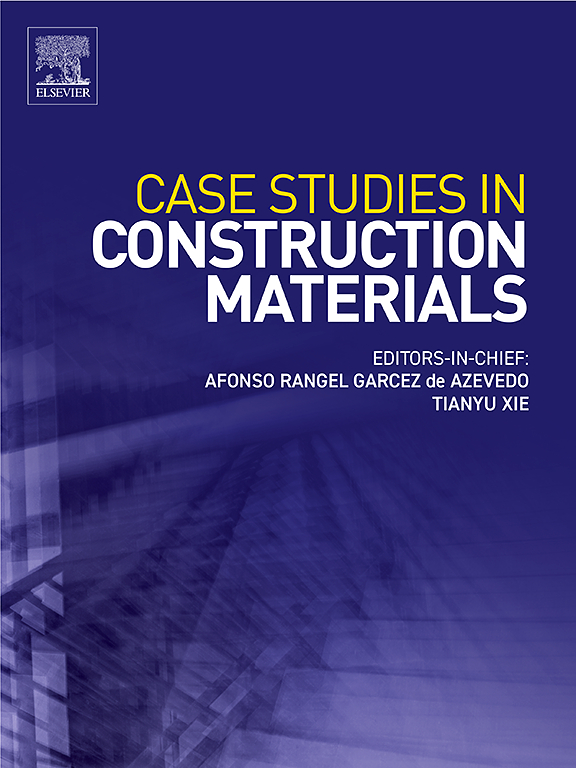Compressive behavior of prestressed SFRCFST stub columns after heating: Effect of fresh concrete compression technique
IF 6.6
2区 工程技术
Q1 CONSTRUCTION & BUILDING TECHNOLOGY
引用次数: 0
Abstract
One innovative and effective technique to enhance the compression response of concrete-filled steel tube (CFST) columns is the compression of the fresh concrete, which actively confines the concrete core by prestressed steel tubes. To utilize active confinement in structural design, the behavior of prestressed CFST columns under different conditions should be investigated. In this research, the compression response of steel fiber-reinforced concrete-filled steel tube (SFRCFST) stub columns prestressed by the fresh concrete compression (FCC) technique was assessed before and after experiencing heat. Toward this goal, 60 cylindrical SFRCFST specimens were fabricated, with key variables of the prestressing ratio, volume percentage of steel fibers, applied temperature, external diameter-to-wall thickness ratio (D/t) of steel tube, and water/cement ratio. Post-heating axial compression tests examined the loading capacity, ductility, peak strain, toughness, and load-strain response. It was revealed that due to prestressing and the temperature rise to 600 °C, the heat-induced reduction in load capacity was negligible, while this drop was notable in the specimens without prestressing. At a temperature of 600°C, the load-bearing capacity of the specimens with a prestressing ratio of 0.5 fy increased by 40 % compared to the non-confined specimens, while the axial and lateral strain capacities decreased by 40 and 49 %, respectively. With an increase in the prestressing ratio to 0.7 fy, the load-bearing capacity increased by 50 %, and the axial and lateral strain capacities decreased by 26 and 25 %, respectively. In prestressed and non-prestressed SFRCFST columns, with or without thermal exposure, a steel fiber content of up to 1.5 % improved toughness and increased peak strain and ductility in most specimens. Finally, the nonlinear regression analysis was employed to present a proper prediction model for the loading capacity of SFRCFST columns.
加热后预应力钢纤维混凝土短柱压缩性能:新混凝土压缩技术的影响
一种提高钢管混凝土柱压缩响应的创新和有效技术是新混凝土的压缩,它通过预应力钢管主动限制混凝土核心。为了在结构设计中应用主动约束,需要对预应力钢管混凝土柱在不同工况下的受力性能进行研究。本文研究了采用新混凝土压缩(FCC)技术预应力钢纤维增强钢管混凝土(SFRCFST)短柱受热前后的压缩响应。为此,以预应力比、钢纤维体积百分比、施加温度、钢管外径/壁厚比(D/t)、水灰比为关键变量,制作了60个圆柱形钢纤维混凝土试件。加热后的轴向压缩试验检测了载荷能力、延性、峰值应变、韧性和载荷-应变响应。结果表明,在温度升高至600℃时,预应力对试件承载能力的热致降低可以忽略不计,而在不加预应力的情况下,热致降低幅度明显。在600℃下,预应力比为0.5 fy的试件的承载能力比无约束试件提高了40 %,而轴向应变能力和侧向应变能力分别降低了40 %和49 %。当预应力比增加到0.7 fy时,其承载能力提高了50 %,轴向应变能力和侧向应变能力分别降低了26 %和25 %。在有或没有热暴露的预应力和非预应力钢纤维混凝土柱中,钢纤维含量高达1.5 %改善了大多数试件的韧性,增加了峰值应变和延性。最后,采用非线性回归分析方法,建立了合理的钢筋混凝土混凝土柱承载力预测模型。
本文章由计算机程序翻译,如有差异,请以英文原文为准。
求助全文
约1分钟内获得全文
求助全文
来源期刊

Case Studies in Construction Materials
Multiple-
CiteScore
7.60
自引率
19.40%
发文量
842
审稿时长
63 days
期刊介绍:
Case Studies in Construction Materials provides a forum for the rapid publication of short, structured Case Studies on construction materials. In addition, the journal also publishes related Short Communications, Full length research article and Comprehensive review papers (by invitation).
The journal will provide an essential compendium of case studies for practicing engineers, designers, researchers and other practitioners who are interested in all aspects construction materials. The journal will publish new and novel case studies, but will also provide a forum for the publication of high quality descriptions of classic construction material problems and solutions.
 求助内容:
求助内容: 应助结果提醒方式:
应助结果提醒方式:


